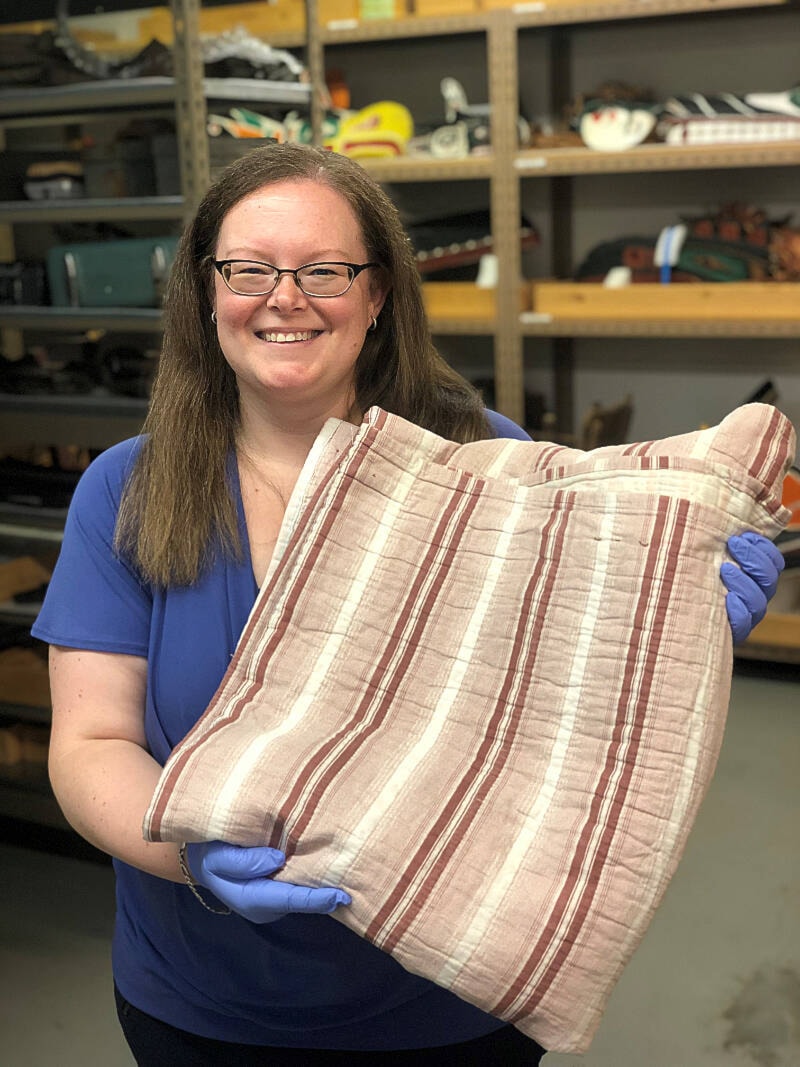Written by the Museum at Campbell River with support from Maxine March
As we march forward in time, the first-hand accounts of the world wars are gradually fading into the past. A recent addition to the Museum at Campbell River’s collection serves as a poignant reminder of a time when communities rallied together to support one another, even across vast oceans.
Despite being thousands of kilometers away from the front lines, the effects of World War II were deeply felt here in Campbell River. In honour of Remembrance Day, the Museum aims to shed light on a lesser-known contribution to the war effort that was done by local women.
World War II brought about numerous shortages in Britain. Countless individuals lost everything during bombing raids leaving evacuees, hospital patients, children in nurseries, and orphanages in need of warm clothing and bedding. In response, the Red Cross issued a plea for supplies, encouraging people across the Commonwealth to contribute whatever they could spare. The women of Canada responded with unparalleled generosity, creating an estimated 400,000 hand-made quilts that were sent to Britain during the war.
This extraordinary act of kindness had nearly faded into obscurity until three friends in Britain decided to bring it back to the forefront. In 2005, Anna Mansi, Jackie Maxwell, and Maxine March attended a talk about Canadian quilts sent by the Canadian Red Cross to the UK for civilian relief during the war. It left a lasting impression on each of them, as they were avid quilters with a keen interest in the craft’s history. Shortly after, one of them stumbled upon one of these quilts in a charity shop where she volunteered, sparking their curiosity and prompting them to embark on a mission to uncover more.
Thus began their research group, dedicated to rescuing as many quilts as possible, sharing their remarkable stories, and ultimately bringing these quilts back home to Canada. Over the course of 18 years, the group meticulously documented over 200 quilts and assembled a collection of more than 100.
The quilts in the collection predominantly feature utilitarian designs, showcasing a wide range of traditional patchwork patterns. From simple blocks to more intricate designs like Crazy, Log Cabin, and geometric patterns, these quilts exemplify the resourcefulness and determination of their makers. The quilt tops are primarily composed of fabric scraps, displaying ingenuity along with beautiful design. Cotton fabrics, particularly dress cottons and feedsack designs, dominate the collection, alongside winceyette, corduroy, furnishing fabrics, and shirtings. The Log Cabin and Crazy designs boast an array of fabrics, including wool, linen, rayon, and even luxury materials such as silk, crepe, georgette, and chiffon.
Each completed quilt has a small label, measuring 3cm by 3.5cm, with the inscription “Gift of Canadian Red Cross.” Some labels also indicate the town or province where the quilt was made, serving as the only identifying mark of the makers. Rarely, a quilt includes an embroidered group name on the top. Once collected or delivered to the nearest Red Cross center, the quilts were shipped to Britain where they were received, stored, and distributed by the British Red Cross and organizations like the Women’s Voluntary Service who then gave to families in need.
As the collection grew, it became apparent that no single institution could house it in its entirety. However, curator Lucie Heins from the Royal Alberta Museum (RAM) in Edmonton, Alberta, stepped in to assist. In addition to adding some quilts to the RAM’s collection, Heins reached out to museums and organizations across Canada, aiming to distribute the collection as widely as possible.
Surprisingly, many Canadians were unaware of the tremendous contributions made by their country’s quiltmakers to support the UK population during the war. Of the over 400,000 quilts that made their way across the Atlantic, more than 60 are finding their way back home to Canada, including one at the Museum at Campbell River.
In honour of Remembrance Day, the Museum will proudly display one of these remarkable quilts during the week leading up Nov. 11. We invite the public to visit and witness this extraordinary piece of history, allowing us to remember and appreciate the selflessness and resilience of those who came before us.
